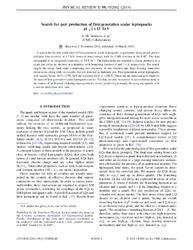Search for pair production of first-generation scalar leptoquarks at √s = 13 TeV
| dc.contributor.author | Sirunyan, A. M. | |
| dc.contributor.author | Işıldak, Bora | |
| dc.date.accessioned | 2020-08-12T20:26:23Z | |
| dc.date.available | 2020-08-12T20:26:23Z | |
| dc.date.issued | 2019-03-19 | |
| dc.identifier.issn | 2470-0010 | en_US |
| dc.identifier.uri | http://hdl.handle.net/10679/6771 | |
| dc.identifier.uri | https://journals.aps.org/prd/abstract/10.1103/PhysRevD.99.052002 | |
| dc.description.abstract | A search for the pair production of first-generation scalar leptoquarks is performed using proton-proton collision data recorded at 13 TeV center-of-mass energy with the CMS detector at the LHC. The data correspond to an integrated luminosity of 35.9 fb(-1). The leptoquarks are assumed to decay promptly to a quark and either an electron or a neutrino, with branching fractions beta and 1 - beta, respectively. The search targets the decay final states comprising two electrons, or one electron and large missing transverse momentum, along with two quarks that are detected as hadronic jets. First-generation scalar leptoquarks with masses below 1435 (1270) GeVare excluded for beta = 1.0(0.5). These are the most stringent limits on the mass of first-generation scalar leptoquarks to date. The data are also interpreted to set exclusion limits in the context of an R-parity violating supersymmetric model, predicting promptly decaying top squarks with a similar dielectron final state. | en_US |
| dc.description.sponsorship | BMBWF and FIVE (Austria); FNRS and FWO (Belgium); CNPq, CAPES, FAPERJ, FAPERGS, and FAPESP (Brazil); MES (Bulgaria); CERN; CAS, MoST, and NSFC (China); COLCIENCIAS (Colombia); MSES and CSF (Croatia); RPF (Cyprus); SENESCYT (Ecuador); MoER, ERC IUT, and ERDF (Estonia); Academy of Finland, MEC, and HIP (Finland); CEA and CNRS/IN2P3 (France); BMBF, DEG, and HGF (Germany); GSRT (Greece); NKFIA (Hungary); DAE and DST (India); IPM (Iran); SFI (Ireland); INFN (Italy); MSIP and NRF (Republic of Korea); MES (Latvia); LAS (Lithuania); MOE and UM (Malaysia); BUAP, CINVESTAV, CONACYT; LNS; SEP, and UASLP-FAI (Mexico); MOS (Montenegro); MBIE (New Zealand); PAEC (Pakistan); MSHE and NSC (Poland); FCT (Portugal); JINR (Dubna); MON, RosAtom, RAS, RFBR, and NRC KI (Russia); MESTD (Serbia); SEIDI; CPAN; PCTI, and FEDER (Spain); MOSTR (Sri Lanka); Swiss Funding Agencies (Switzerland); MST (Taipei); ThEPCenter, IPST, STAR, and NSTDA (Thailand); TUBITAK and TAEK (Turkey); NASD and SFER (Ukraine); STFC (United Kingdom); DOE and NSF (USA). Individuals have received support from the Marie Curie program and the European Research Council and Horizon 2020 Grant, Contract No. 675440 (European Union); the Leventis Foundation; the A. P. Sloan Foundation; the Alexander von Humboldt Foundation; the Belgian Federal Science Policy Office; the Fonds pour la Formation a la Recherche dans l'Industrie et dans l' Agriculture (FRIA-Belgium); the Agentschap voor Innovatie door Wetenschap en Technologie (IWT-Belgium); the F. R. S.-FNRS and FWO (Belgium) under the "Excellence of Science-EOS"-be.h Project No. 30820817; the Ministry of Education. Youth and Sports (MEYS) of the Czech Republic; the Lendulet ("Momentum") Program and the Janos Bolyai Research Scholarship of the Hungarian Academy of Sciences, the New National Excellence Program UNKP, the NKFIA Research Grants No. 123842, No. 123959, No. 124845, No. 124850, and No. 125105 (Hungary); the Council of Science and Industrial Research, India; the HOMING PLUS program of the Foundation for Polish Science, cofinanced from European Union, Regional Development Fund, the Mobility Plus program of the Ministry of Science and Higher Education, the National Science Center (Poland), Contracts Harmonia No. 2014/14/M/ST2/00428, Opus No. 2014/13/B/ST2/02543, No. 2014/15/B/ST2/03998, and No. 2015/19/B/ST2/02861, Sonata-bis No. 2012/07/E/ST2/01406; the National Priorities Research Program by Qatar National Research Fund; the Programa Estatal de Foment de la Investigacion Cientifica y Tecnica de Excelencia Maria de Maeztu, Grant No. MDM-2015-0509 and the Programa Severo Ochoa del Principado de Asturias; the Thalis and Aristeia programs cofinanced by EU-ESF and the Greek NSRF; the Rachadapisek Sompot Fund for Postdoctoral Fellowship, Chulalongkom University and the Chulalongkom Academic into Its 2nd Century Project Advancement Project (Thailand); the Welch Foundation, contract C-1845; and the Weston Havens Foundation (USA). | |
| dc.language.iso | eng | en_US |
| dc.publisher | American Physical Society | en_US |
| dc.relation.ispartof | Physical Review D | |
| dc.rights | openAccess | |
| dc.title | Search for pair production of first-generation scalar leptoquarks at √s = 13 TeV | en_US |
| dc.type | Article | en_US |
| dc.description.version | Publisher version | en_US |
| dc.peerreviewed | yes | en_US |
| dc.publicationstatus | Published | en_US |
| dc.contributor.department | Özyeğin University | |
| dc.contributor.authorID | (ORCID 0000-0002-0283-5234 & YÖK ID 124605) Işıldak, Bora | |
| dc.contributor.ozuauthor | Işıldak, Bora | |
| dc.creator | The CMS Collaboration | |
| dc.identifier.volume | 99 | en_US |
| dc.identifier.issue | 5 | en_US |
| dc.identifier.wos | WOS:000461906000002 | |
| dc.identifier.doi | 10.1103/PhysRevD.99.052002 | en_US |
| dc.identifier.scopus | SCOPUS:2-s2.0-85064394773 | |
| dc.contributor.authorMale | 1 | |
| dc.relation.publicationcategory | Article - International Refereed Journal - Institution Academic Staff |
Files in this item
This item appears in the following Collection(s)
Share this page



